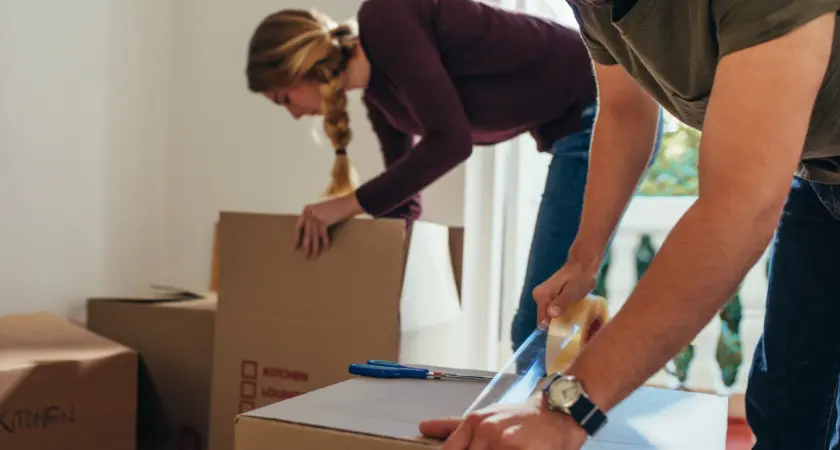DIY Packing Materials for Moving: Where to Save or Splurge

Moving is never cheap.
You may lose a rental deposit and hours at work, and then there’s the time investment, the stress, and the sheer exhaustion, not to mention the expenses of hiring movers, renting a truck, and buying boxes and packing materials.
Most moving expenses are unavoidable, but what about packing materials? With DIY hacks and savvy shopping strategies, you can sharply reduce your moving costs without compromising quality or safety.
Why Packing Materials Matter
From fragile glassware to bulging wardrobes, having the right materials can mean the difference between a stress-free move and a carload of broken treasures.
But not every item requires premium-grade packaging. A smart balance of DIY and store-bought supplies can protect your items while keeping costs low.
Where to Save on Packing Materials
The following items can be easily substituted with budget-friendly DIY or free alternatives.
1. Boxes
Most moving companies suggest buying new boxes (from them), but the reality is that you can find clean, sturdy boxes gratis.
Where to find clean free boxes
- Office supply stores, bookstores, or liquor stores.
- Ask friends, family, or neighbors.
- Look on Craigslist or Facebook Marketplace — people often give boxes away post-move.
Pro Tip: Always inspect free boxes for damage or pests before using them!
2. Cushioning & Padding
DIY alternatives
- Use old newspapers or magazines to wrap fragile items.
- Towels, sweaters, and other soft clothing can cushion glassware and plates.
- Save bubble wrap and styrofoam peanuts for extremely vulnerable items — reuse from packages if possible.
Savings tip: Avoid splurging on premium bubble wrap unless necessary.
3. Garment Bags
Cheap alternative
- Don’t purchase garment bags for clothes you hang. Instead, secure a plastic garbage bag over the bottom of the hangers, leaving the hanger hooks exposed.
Keep folded clothes in place
- Pack folded clothing into suitcases, tote bags, or storage bins you already own.
4. Packing Paper
- You don’t need fancy specialty packing paper. Dollar store supplies, like brown craft paper or butcher paper, provide excellent padding at a fraction of the price.
- Use old notebooks or even junk mail for extra padding when necessary.
5. Furniture Covers
- Instead of buying plastic sheeting, use old sheets, blankets, or comforters to protect furniture from dirt and scratches during transport.
Where to Splurge on Packing Materials
While saving is great, there are times you should never skimp on packing materials. Investing here ensures safety and peace of mind.
1. Packing Tape
- High-quality packing tape is non-negotiable. Cheap tape can peel, lose stickiness, or break, putting your belongings at risk.
- Buy from trusted brands to avoid having to double-layer low-grade tape.
2. Specialty Boxes for Fragile Items
When to consider specialty boxes
- Large items like TVs or mirrors.
- Dish-packing boxes that come with dividers for plates and glassware.
Why they’re worth it
- Specialty boxes provide stronger protection for breakables, saving you from costly replacements later.
3. Labels & Markers
- Labels ensure clear organization, making unpacking faster and less stressful.
- Use color-coded labels or markers (e.g., blue for kitchen items, orange for bedroom belongings).
- Pre-made label packs can save time.
4. Mattress Covers
- Mattresses can quickly collect dirt, tears, or stains during a move. A durable plastic mattress cover is far cheaper than replacing an expensive mattress.
5. Stretch Wrap
- Secures drawers and doors on furniture (like dressers and cabinets).
- Keeps oddly shaped items together.
- Stretch wrap is versatile and inexpensive but provides a professional-level solution for securing items.
6. Cargo Straps or Bungee Cords
- If you’re moving with a truck or van, these keep your items from shifting during transit. A small investment here can prevent major on-the-road headaches.
Bonus DIY Packing Hacks for Moving
- Keep drawers packed: Leave lightweight items like clothing in drawers and secure them with plastic wrap. This saves time and boxes.
- Use luggage for heavy items: Pack books or other weighty items in rolling suitcases to prevent overloading cardboard boxes.
- Color-code your boxes: Instead of labeling every box with text, assign each room a color. Use colored tape or markers to match your boxes to their destination.
- Reusable plastic bins: Invest in a few sturdy plastic bins that can later be repurposed for storage at your new home.
FAQs: DIY Packing Materials for Moving
Q: Are free packing boxes reliable enough?
Free packing boxes are often just as sturdy as store-bought options. However, before using them, be sure to inspect them for damage, water stains, or pests.
Q: What’s the best material for fragile items?
Use a mix of bubble wrap, clothing, or old newspapers to wrap fragile items. For high-value breakables, consider specialty packing boxes with dividers.
Q: Can I save money by renting packing materials?
Absolutely. Renting reusable bins or padding materials can reduce waste and save you the upfront cost of buying supplies. Check out local rental or moving companies for options.
Q: How can I reduce waste during packing?
Reuse materials you already have (clothing, towels, old boxes), rent reusable bins if available, and recycle materials after unpacking to reduce waste.
Q: How much should I budget for packing materials?
Costs depend on the size of your move, but you can keep your budget in check by mixing free and splurge-worthy materials. On average, budget $50–$100 for high-priority items like tape, labels, stretch wrap, or specialty boxes.
Q: How far in advance should I gather packing materials?
Start gathering packing materials at least 4–6 weeks before your move. This will give you ample time to source free boxes, purchase essential supplies, and avoid last-minute scrambling.
Q: Are there eco-friendly packing materials available?
Eco-friendly options include recycled cardboard boxes, biodegradable packing peanuts, and reusable bins. Additionally, using materials you own (like clothing and towels) for cushioning can minimize waste and reduce your environmental footprint.
More Moving Tips

0 Comments